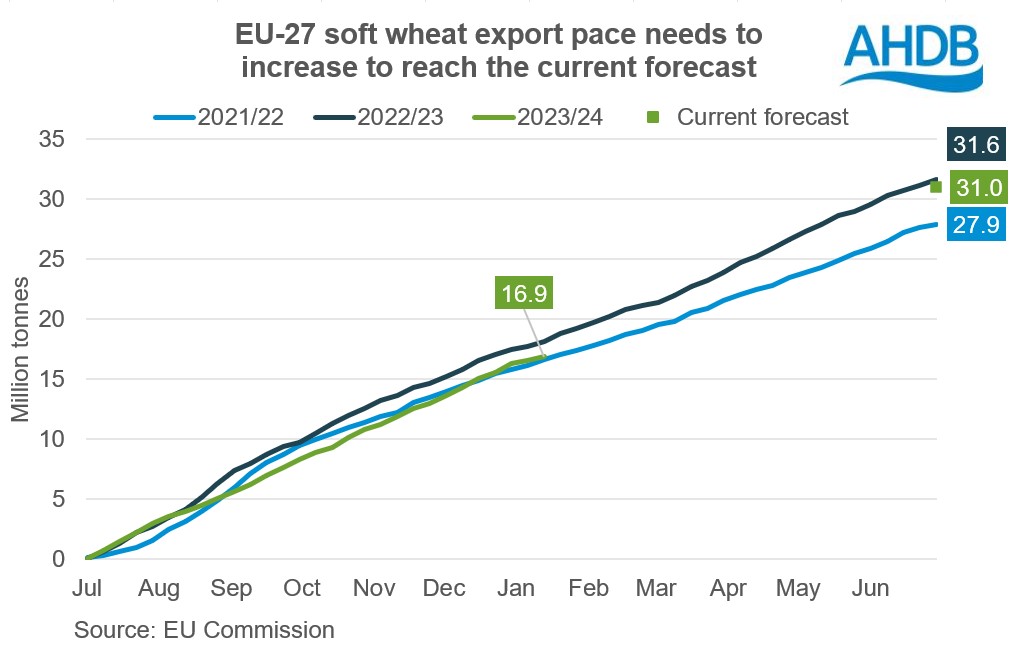Is Black Sea price pressure easing? Grain market daily
Friday, 19 January 2024
Market commentary
- Old crop UK feed wheat futures rose yesterday, as global wheat prices picked up after falling in the early part of the week. The May-24 contract closed at £186.25/t, up £1.00/t. However, the Nov-24 contract lost a further £0.20/t to close at £199.55/t.
- Strategie Grains has cut over 2 Mt from its projection of the 2024 EU-27 wheat crop (exc. Durum) to 122.7 Mt, due to a smaller German area. The company also increased its 2024 barley crop forecast by 0.7 Mt to 4 Mt, which would be up 13% from 2023.
- May-24 Paris rapeseed future gained €7.50/t yesterday to close at €437.00/t, while the Nov-24 contract gained €5.75/t to €438.00/t. Rapeseed prices were supported by higher Chicago soyabean prices (which rose after the nearby price hit a two-year low earlier in the week) and stronger palm oil futures prices.
- The size of the Brazilian soyabean crop is again in focus for oilseed markets, as a crop tour organised by Agroconsult gets underway. The private forecasters currently peg the crop at 153.8 Mt, 5.0 Mt lower than in December and 3.2 Mt below the USDA.
Is Black Sea price pressure easing?
Slower EU wheat exports contributed to lower European and so UK wheat prices in the first half of the 2023/24 marketing season.
EU exports are 7% slower than last season at 16.9 Mt (1 Jul - 14 Jan, EU Commission customs surveillance data). This equates to just 54% of the EU Commission’s current export forecast for the season (31.0 Mt). Last season, the EU had exported 57% of the full season total by this point in the year and 60% in 2021/22. The export pace needs to increase to prevent EU wheat stocks rising, given the stronger import pace. The EU has already imported 79% of its full season forecast, versus just 51% by this point last season.
One of the key reasons the EU export pace has struggled is competition from Black Sea, particularly Russian supplies.
The 2023 Russian wheat crop was very large at an estimated 91.0 Mt, just 1.0 Mt below last year’s record (USDA). Despite the export price regulations, Russian wheat has still been highly competitive and exports got off to a rapid start. The strong pace continued into winter and SovEcon estimates Russia will have exported over 30 Mt by the end of this month (LSEG). This would be 15% more than the first seven months of 2022/23.
But there are signs that the price pressure from Black Sea exports could be starting to ease. The gap between EU and Russian prices has narrowed and Egypt’s state-buyer, GASC, bought French wheat for the first time in five and a half months this week. GASC bought 60 Kt of French wheat for a reported $284.50/t cost and freight, slightly ($0.70/t) below the purchase prices reported for Russian wheat (LSEG).
One factor that has likely helped EU wheat become more competitive is that the euro weakening against the US dollar from where it was in December.
Looking ahead
SovEcon forecasts that Russian wheat exports could total 48.6 Mt this season. To hit that target, Russia will still need to ship around 3.7 Mt each month from February to June, which is down from the average of 4.3 Mt so far this season. There are also reports that Ukraine exports could drop 20% in January down due to the issues around the Suez canal and in the Red Sea.
This could mean greater opportunities for EU exports and perhaps some relief in terms of price pressure on European and, consequently, UK wheat prices in the remainder of the 2023/24 season. However, it is unlikely to mean much support, as there is still a large volume of Russian wheat to ship.
Sign up to receive the latest information from AHDB.
While AHDB seeks to ensure that the information contained on this webpage is accurate at the time of publication, no warranty is given in respect of the information and data provided. You are responsible for how you use the information. To the maximum extent permitted by law, AHDB accepts no liability for loss, damage or injury howsoever caused or suffered (including that caused by negligence) directly or indirectly in relation to the information or data provided in this publication.
All intellectual property rights in the information and data on this webpage belong to or are licensed by AHDB. You are authorised to use such information for your internal business purposes only and you must not provide this information to any other third parties, including further publication of the information, or for commercial gain in any way whatsoever without the prior written permission of AHDB for each third party disclosure, publication or commercial arrangement. For more information, please see our Terms of Use and Privacy Notice or contact the Director of Corporate Affairs at info@ahdb.org.uk © Agriculture and Horticulture Development Board. All rights reserved.



